Formula One: 1987 Monaco GP
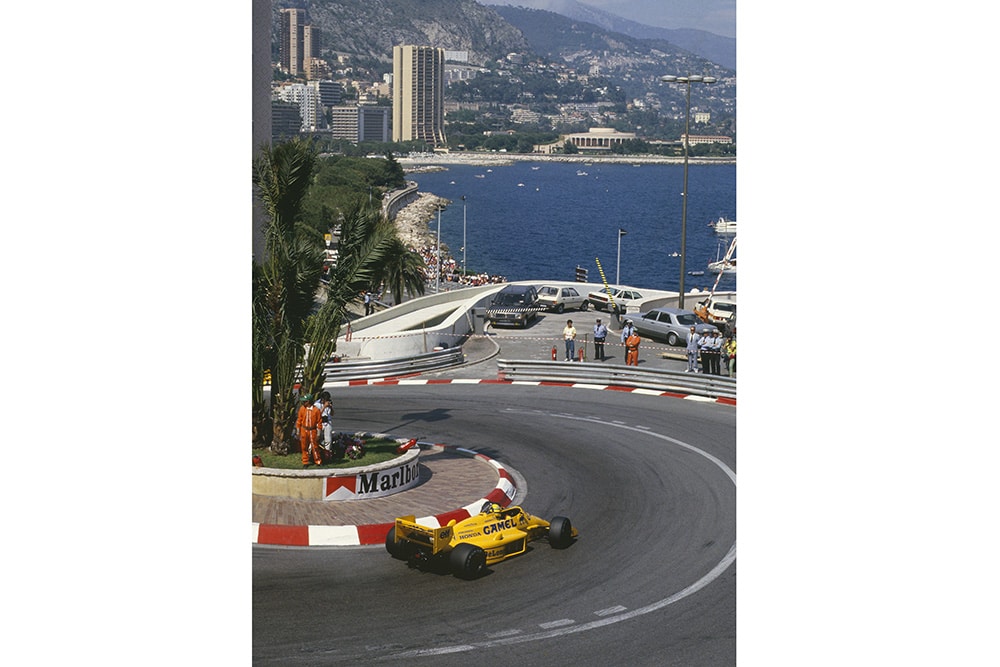
Ayrton Senna driving Lotus 99T Honda to 1st position.
© Motorsport Images
The Rising Sun in Dreamworld
If you need an example of an anachronism, it has to be the Monaco Grand Prix. Walking round the circuit the day before practice began, I could not help feeling that Monaco itself was living in a dream world, oblivious to the rest of the world. and to the fact that we have nearly reached the end of the nineteen-eighties and the year 2000 is in sight.
The Casino Square, which has for so long retained an air of gentle Victorianism, now looked as though it had suffered an air raid! The Café de Paris and its surrounding buildings, which had stood the test of time, were now a shattered shell littered with rubble, dust and rubbish, as developers attacked the scene. The once genteel gardens on the slope down to the square were gone, and there was a gigantic hole in the ground, heralding the impending arrival of an enormous underground car park; the builders’ hoardings surrounding the ugly scene had been beautifully painted with sylvan scenes, though among them were some signs of old fashioned surrealism.
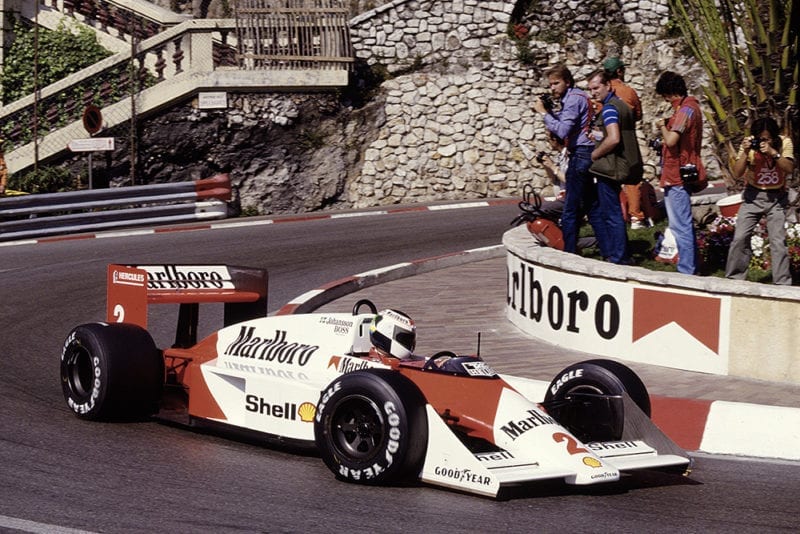
Stefan Johansson in his McLaren MP4/3 TAG Porsche.
© Motorsport Images
The temporary grandstand which overlooked the square was now on the grass island in the centre of the square with a view of very little except the building site. I looked at the Casino itself and wondered how long before it too would suffer from the bull-dozer.
All around the town the guardrails had been installed, the scaffolding for the grandstands erected, and the fencing to shut off the roads was in place. A subterranean road seemed to be coming up out of the ground where the old gas-works once was, and the dust-carts were at the ready to collect the vast amount of rubbish which would be thrown on the ground by the expected 40,000 paying customers.
A motley collection of boats was cramming into the harbour parking spaces, some being sleek powerboats, others being pretentious “hired” motor cruisers, and some (sadly flying British flags) being plain vulgar in their decor. On the western quayside all the teams were parked, with their huge articulated transporters neatly wedged into the minimum of space, and large working areas covered by awnings. Team motor-homes and tentage were precariously near the edge of the harbour wall, and the giant Elf petrol and oil company had been told there was no room for its hospitality motor-home which normally gives succour to members of the press, the trade and any driver who feels the need to escape from his own team’s darkened motor-home for a quiet respite!
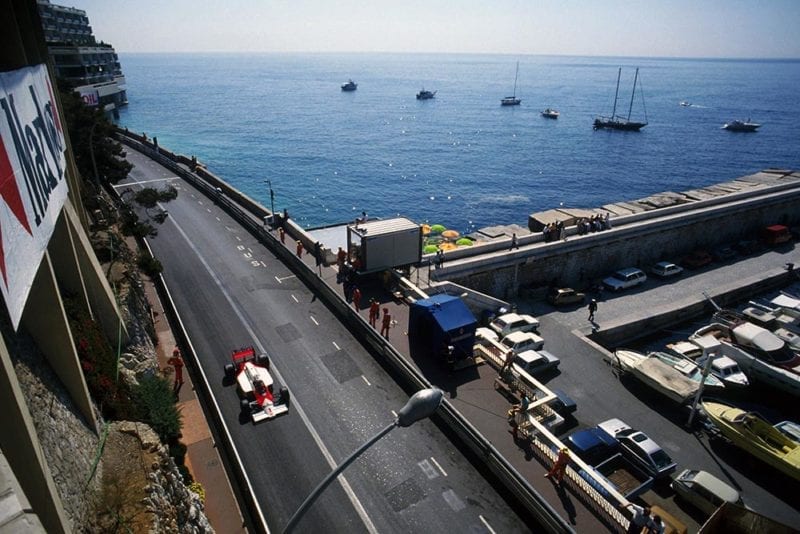
Alain Prost in his McLaren MP4/3.
© Motorsport Images
The action began on Thursday morning, as the 1987 teams made their first contact with the street circuit, there being no pre-race testing possible at Monaco. Practice, or testing, and the one hour of qualifying took place on Thursday and Saturday (Friday being reserved for supporting races’ practice), and throughout the two days all the usual dramas and problems appeared — from the domination of Nigel Mansell and his Williams-Honda to the exclusion of Christian Danner and the withdrawal of Adrian Campos. Engines were broken, gearboxes were broken, cars were stranded out in the streets with electrical breakdown, and every now and then there would be a sickening thud as a car crashed into the unforgiving guardrails.
The worst of these thuds was shortly after qualifying had begun on Thursday afternoon. Danner was accelerating relatively slowly up the hill from the pits to the Casino Square when Alboreto came storming round on a flying lap, the Ferrari pursued by Senna in the yellow Lotus-Honda. The Brazilian driver saw in a flash that their pace was going to bring them onto the tail of the Zakspeed as they arrived at the brow of the hill, with little hope of overtaking until out of the square, so he aborted his lap and backed off.
Not so Alboreto. He either was not looking far enough ahead, or miscalculated the speed differential. The result was that the Ferrari did not make the closing gap. It struck the left front wheel of the Zakspeed, aviated, and tore itself to pieces as it clanged about between the guardrails. The whole rear end of gearbox and suspension broke off at the bell-housing, the entire nose and pedal assembly broke off the front, and a very lucky Italian climbed out of the wreckage unhurt, helped over the barriers by the embarrassed Christian Danner.
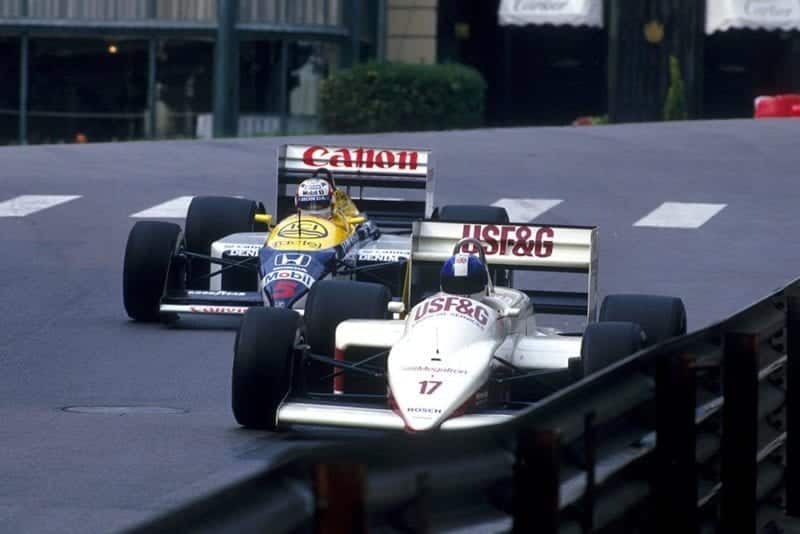
Derek Warwick (Arrows A10) leads Nigel Mansell at Casino Square.
© Motorsport Images
The outcome was that the Stewards listened to eye-witnesses of the impact, put the blame on Danner and excluded him from any further participation in the meeting. They do not seem to have investigated events leading up to the impact, as later described by Senna.
Back in the winter it was announced by FISA/FOCA, without any preliminary open discussion, that this year 26 cars would be allowed to start the race rather than the normal restriction to 20; a limit put on with regard to the limited space on the circuit. In the days before safety was the almighty god, the Automobile Club of Monaco used to limit the number of starters to 16!
Not surprisingly there was a lot of opposition to this sudden new rule, especially from some of the drivers, but FISA/FOCA were adamant. With the strange exclusion of Danner, it looked as though someone was getting cold feet and looking for a way out. On Saturday Adrian Campos had a pretty predictable spin in the Casino Square during morning practice, and thumped the guardrails; the car was not destroyed but it was broken, and he walked back to the pits. Later it was announced that he had felt unwell on arriving at the pits, and the next thing we knew was that he had been withdrawn from the race suffering from “omnabulation” (whatever that is), and was being kept in hospital until Monday morning for observation. Two down and four to go, then we would be back to the acceptable 20 starters.
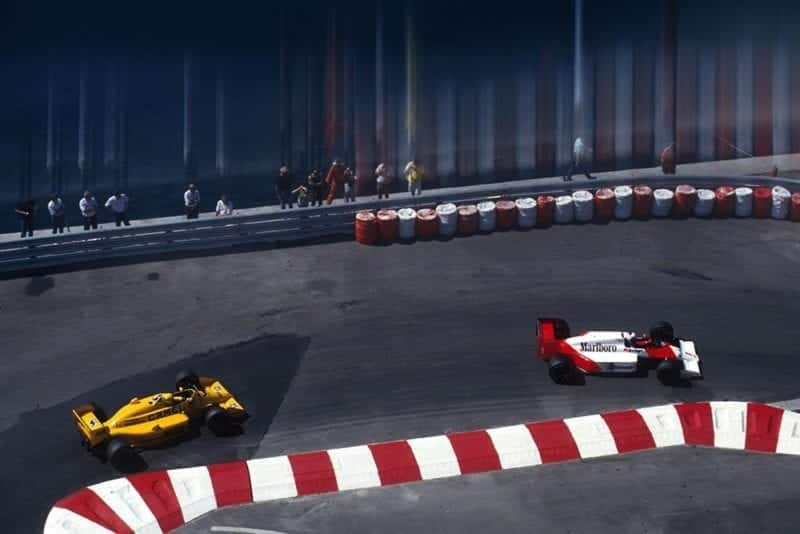
Alain Prost (Mclaren MP4/3) leads race winner Ayrton Senna (Lotus 99t).
© Motorsport Images
After his accident on Thursday afternoon, Alboreto was quite unmoved and qualified in the spare Ferrari, but team-made Gerhard Berger did not go far before he stuffed his Ferrari nose-first into the Armco, and there was no spare car for him. The Williams drivers each had a spare car in the pit lane; neither of them needed it, though they tried them out, just in case.
The Benetton team lost a car when Fabi slid on oil as he joined the harbour front road and crunched the left front suspension right into the monocoque. Streiff gave the Tyrrell mechanics plenty of work when he crashed his Cosworth-powered car, and Patrese pushed things out of line on his Braham BT56 when he misjudged a corner.
Any driver who can get through four sessions round the streets of Monte Carlo without inflicting damage to his car can feel well pleased with himself. It always was thus, even with heavy cars and a mere 300 horsepower, and is more so with today’s projectiles which have up to 900 horsepower and weigh very little.
The outcome of the two qualifying sessions was that Nigel Mansell was in superb form, showing no signs of inhibitions about the circuit, the town, the people, the general scene or anything that people said about him after his “nonsense” at Francorchamps. He was unquestionably fastest on both days and sat on pole position, three-quarters of a second faster than Senna in second place.

Ricardo Patrese at the wheel of his Brabham BT56.
© Motorsport Images
With Piquet third, albeit showing very little enthusiasm for the whole Monaco affair, the sea of yellow faces in the pit lane was radiating pleasure and Honda was again dominant. That Nakajima was down near the back of the grid was of no consequence, for it was the arniable Japanese driver’s first attempt at Monaco, and he had survived the four sessions without damaging the car or himself.
Monaco filled up in its usual way, casual callers at hotels looking for a bed being greeted with the news that there was nothing between Menton and Nice —a bit of an exaggeration, but nonetheless basically true, for visitors seemed to come from all over Europe, judging by the variety of number plates on cars and motorcycles around the town. Italy, France, West Germany, Austria, Great Britain, Switzerland, Sweden, Luxembourg, Spain and Ireland were all well represented and there were coaches from just about ever, where, while firms such as Avis, Hertz and Europcar had done a roaring trade with hire-cars.
Race day was dry and warm, but overcast. Though the lower part of the circuit around the harbour was jam-packed, the grandstand in Casino Square, which had its back to the action this year instead of being a prime site, was nothing like full.
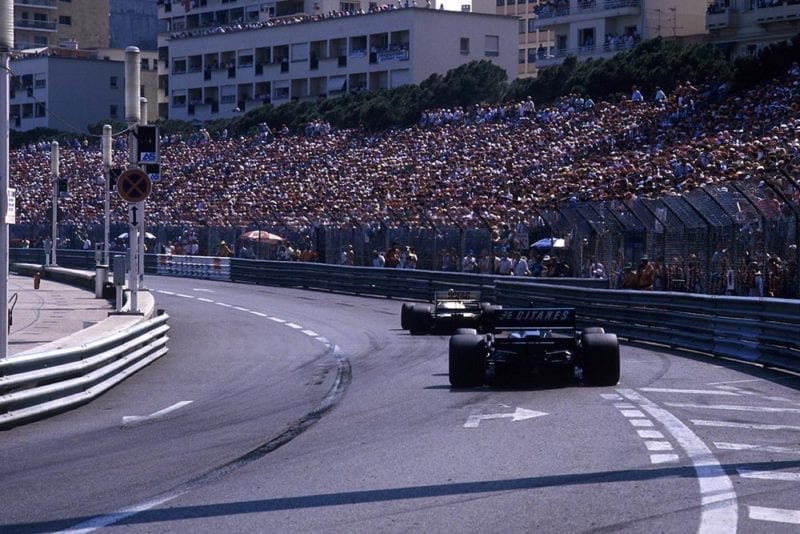
The narrow track of Monaco.
© Motorsport Images
Mansell’s domination of practice made you wonder if this was going to be a dull (or impressive) race dominated by one man and his Honda, but you can never discount Senna. There was just a hope that Piquet would wake Up and show some interest in Monaco street racing, while behind in the Honda trio was the quiet, unemotional Alain Prost in his Porsche-powered McLaren. His usual objective was to win the race by being in the lead on the last lap rather than on the first.
After a first-class start, Mansell led without challenge for 29 laps. He lapped Ivan Capelli in the turquoise March-Cosworth (running second in the non-turbo category) on lap 26, but halfway round lap 30 the Williams suddenly slowed and the March unlapped itself! Mansell cruised into the Williams pit lane, but it was all over. An exhaust pipe had split between the engine and the turbocharger on one bank of cylinders, and all the desirable exhaust gas pressure was leaking into the atmosphere instead of spinning the turbo compressor.
From the start Senna had settled cornfortably into second place, with no intention of mixing it with the unruly “Brummie” but waiting up to see how things developed. As he completed his 30th lap out of 78 he was given the lead on a plate, and with a smile and a “thank you” he ran the rest of the race untroubled. The Lotus mechanics made a faultless tyre change at the end of lap 42, and just for the joy of it Senna made fastest race lap on lap 72, though it was not a new record. Behind him, a seemingly disinterested Nelson Piquet ran in second place, but behind the second Honda there was a different story.
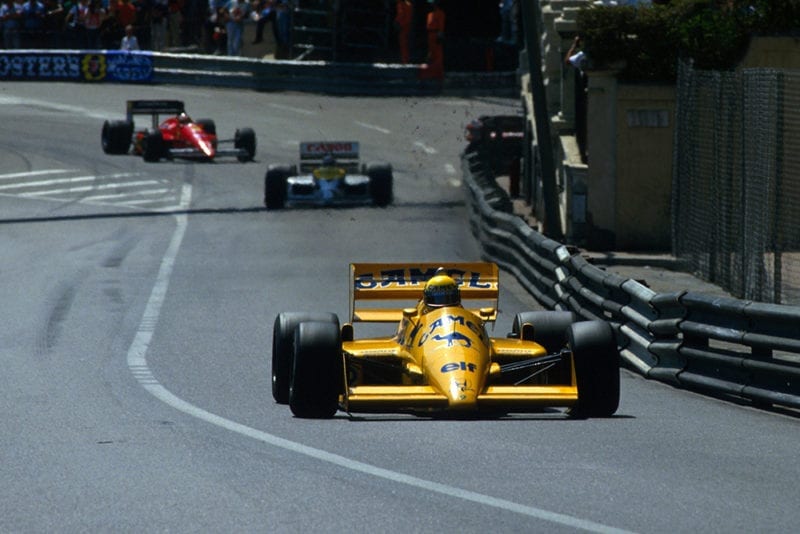
Ayrton Senna leads in his Lotus 99T.
© Motorsport Images
From the start Prost felt his engine was not on full song, and could smell hot oil leaking from somewhere. He was thoroughly bogged down behind Alboreto’s Ferrari, and the Italian was not going to let him by. This hiatus allowed lesser lights to keep up, and Eddie Cheever was really enjoying himself in his BMW-povvered Arrows A10, hurling it about with carefree abandon and harrassing the World Champion’s McLaren. His English team-mate Derek Warwick was having similar fun chasing Berger in the second Ferrari.
During the pit stops for tyres at around half distance, Prost got the better of Alboreto, but it was too late for him to set his sights on the leader, and anyway the Porsche engine was not really working on all six cylinders. Third place was all he could hope for, but even that was denied him on lap 76, with only two to go, for smoke heralded disaster and the engine blew up.
It was a bad day for McLaren and Porsche, for already the number two car had retired in the Casino Square when the engine blew up rather suddenly. Some cynical critics wondered whether McLaren International was behind in its payments to the Porsche Weissach Development Centre, and was having to use second-hand engines! Porsche engines are usually impressively reliable, as we saw at Francorchamps. The Arrows joy-day ended abruptly when, on consecutive laps, Warwick retired with broken gear-linkage and Cheever stopped with a broken engine, but at least the drivers had enjoyed themselves.
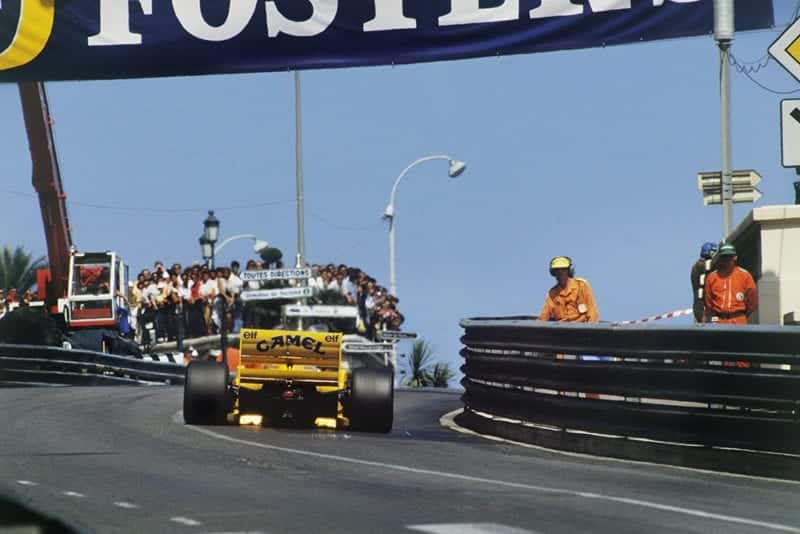
Lotus 99T Honda charges up hill.
© Motorsport Images
Two other drivers who enjoyed their day were Jonathan Palmer and Ivan Capelli, who both drove hard and fast, or as fast as their under-powered Cosworth DFZ engines would propel them. They were two laps behind at the finish, but well-pleased, and Palmer had led category B throughout the race. His team-mate Philippe Streiff had another lurid accident, destroying his second Tyrrell 016 in two weeks, while the main contender in this unturbocharged sub-division, Philippe Alliot in the Larrousse-Calmels Lola, was never in the picture. He had been strong in practice, but collided with Nakajima at Ste Devote corner on the opening lap, and suffered a spin which left him far behind. His Cosworth engine could not stand the strain of his efforts to make up ground, and he retired shortly after half-distance.
The Japanese driver blotted his copy-book slightly at the first corner, but thereafter made up for it by keeping “on the island” and finishing unscathed. Four starts and four finishes must be significant, especially when you look at the record of number two Lotus drivers in past years.
Naturally Team Lotus was delighted to win its first race with the 99T, using its computer-controlled suspension to smooth out the bumps with its “active” hydraulic rams. Whether the victory was due to “Active” or “Ayrton” is difficult to evaluate, but the driver was quite certain that he had had a more comfortable and less fatiguing drive than in the past, especially as regards wear and tear on his hands from the steering-wheel and gear-lever.
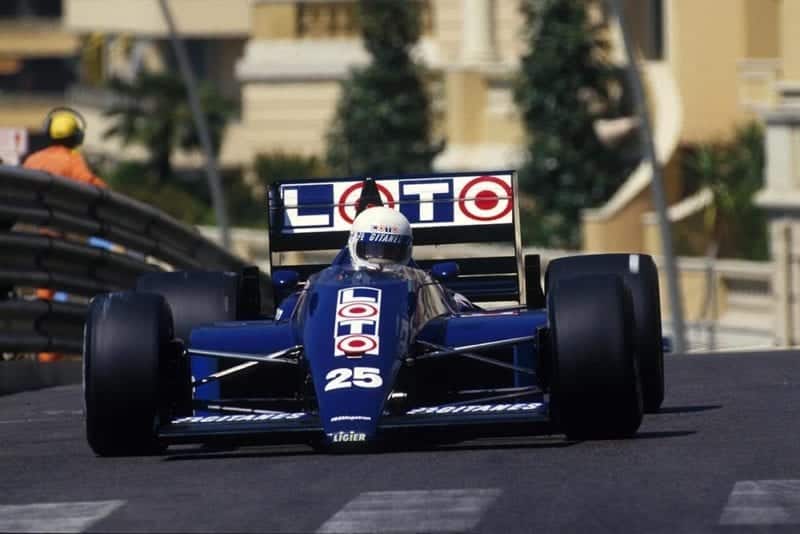
Rene Arnoux in his Ligier JS29B.
© Motorsport Images
Though not featuring in the results, one cannot avoid keeping an interested eye on Alessandro Caffi in the mini-budget Osella with its old V8 Alfa Romeo engine. There it was, hounding Fabi’s Ford-powered Benetton like a good ‘un. Admittedly the Benetton was a bit off-colour and not at all happy on the street circuit but, regardless of that, you don’t expect to see an Osella tucked up behind a Benetton and looking serene and secure. Electrical problems finally stopped Caffi’s run, but he is reminiscent of Martin Brundle when he used to drive the under-powered Tyrrell a couple of years ago. So many lesser drivers moan and complain about their cars and never get stuck in with what they have got.
They think, and sometimes say, that given a Williams or McLaren they would be way out in front, but I am never impressed until I see them doing things with their “under-powered old heaps” which are beyond all reason. Caffi seems to be doing just that.
One team which is an embarrassment to mention, though it can only get better, is Guy Ligier’s. After a fracas with Alfa Romeo, which lost it the new four-cylinder turbo engine, it did an incredible job in switching to BMW power, which involved a major redesign and rebuild. But since then it seems to have fallen apart, the cars being much too heavy and unwieldy compared to the opposition. On the opening lap, they suffered the “classic occasion” as Arnoux and Ghinzani ran into each other. How many times has that happened to other teams? I can recall Lotus, Ferrari, Renault-Alpine, and there were probably others. Both Ligiers were able to continue, and actually kept going to the end, but it was not a very impressive performance and the burly Guy was not amused.
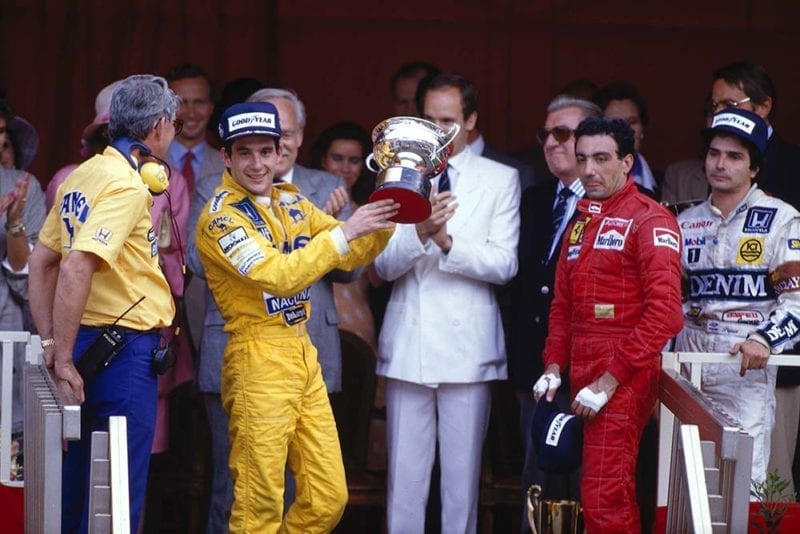
Ayrton Senna, 1st position, Michele Alboreto, 3rd position and Nelson Piquet, 2nd position on the podium. Lotus boss Peter Warr stands next to Senna to collect the constructors prize.
© Motorsport Images
It was with some relief that Monaco was over for another year, for though it is a riot of fun for those who pay to be there and enjoy themselves, those who are paid to be there to work seldom enjoy it. Photographers trying to do a good job for their paper or magazine loath it, as vantage points get fewer and fewer each year; mechanics loath it as the pits are a long way from the paddock and everything has to be humped back and forth; the public in the paddock area are uncontrollable and the light fingered brigade are very active; the instant-press and media people dislike the press nerve-centre being on the fifth floor of a multi-storey car park, a mile vertically and horizontally from the paddock; the pit-lane facilities would be laughed out of court if offered at a permanent circuit, and so it goes on.
But the world at large and the paying customers love it, and the reigning monarch obviously enjoys the whole commotion, so he will make sure it continues. Long may he reign. People who have visited Monaco at other times of the year, for exciting ping-pong, billiards, singing or dancing tournaments, say it is not quite the same. There is nothing quite like the Grand Prix d’Automobile de Monaco, and this one was the 45th, though not the most exciting. DSJ
